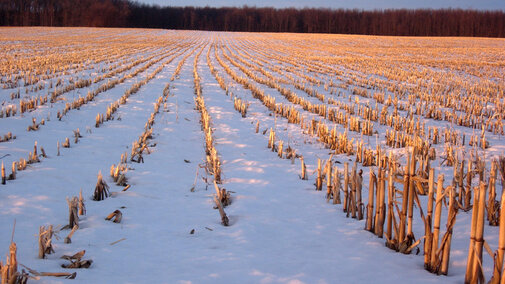Mid-winter Cornstalk Grazing
Here in mid-winter, cornstalks remain a great forage resource for livestock producers. Snow cover on the cornstalks is generally not a problem for cattle as they are adept at digging their way through to get at the leaves, husks and remaining corn that they are seeking. However, if an icy crust develops on the snow, this will limit grazing and supplemental feed may need to be provided.
Another important consideration is the stocking rate and how long they have been in a particular field. Nutritional value of cornstalk residue is greatest at the beginning of a grazing period and declines with time as the most nutritious plant parts are grazed. A general stalk grazing rule — there is about 30 cow days per 100 bushels of corn that the field produced.
Over the fall and winter, weathering can also play a role in reducing cornstalk quality. Rain or melting snow soaks into dry cornstalk residue and leaches out some of the soluble nutrients. Most serious is the loss of sugars and other energy-dense nutrients, which lowers the TDN or energy value of the stalks.
Another factor that affects cornstalk grazing is wind. We have had our share of excessively high winds, which easily blow corn leaves and husks off the field. This, of course, can impact the amount of feed, and after grain, those leaves and husks contain the highest nutritional quality.
Cornstalks are still a great and economical winter feed source. Just be sure to closely monitor cow and field conditions while adjusting your supplementation program accordingly.
High Quality Hay After Calving
Good cow nutrition is crucial following calving to get cows rebred. Today, let's look at the reason for using our top tier hay after calves hit the ground.
Because cows experience a lot of stress after calving, they need good feed. Not only is the cow producing milk for her calf, she is also preparing her reproductive system to rebreed. As a result, nutrient demands are high. Energy requirements increase about 30% and protein needs nearly double after calving. Underfeeding reduces the amount of milk a cow provides her calf, and it can delay or even prevent rebreeding. If it gets cold, wet or icy again, nutrient demands can sky-rocket.
Winter grass, cornstalks and other crop residues are low quality right now because these feeds are weathered and have been pretty well picked over. It is critical that the hay or silage you feed will provide the extra nutrients your cows need.
Because of this, not just any hay or silage will do. Your cow needs 10% to 12% crude protein and 60% to 65% TDN in her total diet. If she is grazing poor quality feeds or eating grass hay, your other forages and supplements must make up any deficiencies.
Make sure your forage has adequate nutrients; if you haven't done so yet, get it tested now for protein and energy content. Compare this to the nutrient requirements of your cows. Then feed your cows a ration that will meet their requirements. Use supplements if needed. But don't overfeed, either. That is wasteful and expensive.
Calving and the months after are a stressful time for cows. If we underfeed, it can delay rebreeding and slow down calf growth. Use your best quality forages with any needed supplements to provide adequate nutrition. By meeting nutrient requirements, your cows will milk well, rebreed on time and produce healthy calves year after year.

